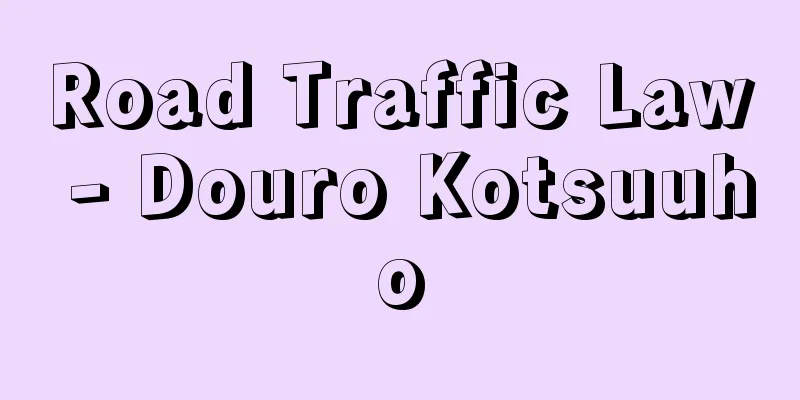Road Traffic Law - Douro Kotsuuho

|
This law stipulates the rules that drivers and pedestrians must follow on the road, and also prescribes various mechanisms for traffic safety. It was enacted in 1960, Law No. 105. Its abbreviation is "Road Traffic Law." It is administered by the National Public Safety Commission (National Police Agency). Its purpose is to prevent dangers on the road, ensure safe and smooth traffic, and contribute to the prevention of road traffic-related problems. [Masahiro Tamura January 21, 2021] HistoryIn the prewar period, the Road Control Order and the Automobile Control Order (both were Ministry of Interior ordinances) stipulated the traffic rules for horses and vehicles and driver's licenses. After the Constitution was enacted, it became impossible to regulate by ordinance, so the Road Traffic Control Law (old law) was enacted in 1947 (Showa 22) (implemented the following year) to stipulate rules and penalties for horses and vehicles and railroad cars. This law stipulated only basic matters, and left the details of traffic rules on roads and driver's licenses to ordinances. Initially, the Road Traffic Control Order (Ministry of Interior ordinance) and from 1953, the Road Traffic Control Law Enforcement Order (Cabinet Order) stipulated specific regulations. With the rapid development of automobile traffic after that, the old law implemented system reforms such as two-way traffic (pedestrians were required to drive on the right side of the road, opposite to horses and vehicles), the introduction of large vehicle licenses (limiting the range of vehicles that could be driven with a regular license), and the creation of a second-class license required to drive passenger vehicles. In 1960, the Road Traffic Law was abolished and the Road Traffic Act was enacted and put into effect. The old law did not adequately regulate the way pedestrians and motor vehicles pass and the responsibilities of motor vehicle drivers, and was not able to respond to the actual traffic situation. In addition, many of the restrictions on the rights and freedoms of citizens were delegated to orders, so this law was enacted as a comprehensive and fundamental law that stipulates the rules of road traffic. The word "regulation" was removed from the name. In addition, while the old law stipulated only traffic safety as its purpose, the smooth flow of traffic was added as a purpose. In addition, the law improved the police officers' authority to regulate, improved regulations regarding road use, strengthened pedestrian protection, and introduced obligations for motor vehicle users. [Masahiro Tamura January 21, 2021] Main ContentsChapter 1, "General Provisions," contains provisions regarding traffic regulations (by road signs, traffic lights, and on-site directions from police officers) in addition to the purpose and definitions of the law. Chapter 2, "How pedestrians pass," contains provisions regarding classification of passage, how to cross, places where crossing is prohibited, instructions by police officers on how to pass, etc. Please note that the provisions regarding pedestrians apply to those who use wheelchairs or walking aids for the physically disabled. Chapter 3, "Traffic Methods for Vehicles and Streetcars," contains various provisions regarding traffic methods (traffic divisions, vehicle lanes, etc.), speed, crossing, overtaking (including maintaining a safe distance between vehicles, prohibiting lane changes, and prohibiting cutting in), passing through railroad crossings, traffic methods at intersections, traffic methods to protect pedestrians and cyclists, emergency vehicles, slowing down and stopping, stopping and parking, measures for illegal stopping and parking, lights and signals, riding, carrying, and towing (restrictions on riding or carrying and permission from the police chief to exceed the restrictions, orders for measures in case of overloading, and danger prevention measures), and prohibitions on driving poorly maintained vehicles. As for bicycles, in addition to the traffic methods for light vehicles that apply, there are also special provisions regarding the permission of riding on sidewalks under certain conditions, traffic methods at intersections, and the wearing of helmets when carrying children or infants. Chapter 4, "Obligations of Drivers and Employers," stipulates the obligations of drivers (prohibitions of driving without a license, while under the influence of alcohol or while fatigued, etc., measures to prevent danger, prohibitions on engaging in dangerous activities with others, the obligation to drive safely, and items that drivers must comply with), measures to take in the event of a traffic accident (driver's obligation to report), and the obligations of users (vehicle owners and other persons who control and manage the operation of the vehicle) (making efforts to ensure that drivers drive safely and comply with laws and regulations, etc.). Chapter 5, "Road Use, etc.", contains provisions regarding prohibited acts on roads, permission to use roads, and measures that the police chief may take to prevent dangers due to illegal structures, etc. Chapter 6, "Driver's Licenses for Motor Vehicles and Mopeds," contains provisions regarding types of driver's licenses, applications, licenses, tests, renewals, and license revocation/suspension. Note that points for violations and accidents are determined by government ordinance, not by this law. In addition, Chapter 6, Section 2, "Training," stipulates courses such as renewal courses, courses for seniors, courses for novice drivers, courses for those with suspended licenses, and courses for those with revoked licenses. "Penalties" are set out in Chapter 8. Among acts that are subject to criminal punishment, special provisions for the handling of acts that are not serious or dangerous are set out in Chapter 9, "Special provisions for the handling of illegal acts." In addition, there are provisions regarding "Special provisions for automobile traffic methods on expressways, etc." (Chapter 4, Section 2), "Traffic Accident Investigation and Analysis Center" (Chapter 6, Section 3), "Promotion of private organizational activities to contribute to traffic safety and smooth traffic flow" (Chapter 6, Section 4), and "Miscellaneous Provisions" (Chapter 7). [Masahiro Tamura January 21, 2021] Revision TrendsSince the enactment of this law, numerous amendments have been made to it in response to various situations in road traffic. The most representative ones are described below. The revised law of 1967 introduced the traffic violation notice system (which came into effect the following year). Because it was difficult to process a large number of violations through criminal proceedings, the law stipulated that prosecution would not be instituted if a traffic violation fine was paid, except for serious and dangerous violations. The 1970 amendment added the purpose of the law to "contribute to the prevention of road traffic-related problems," making it possible to implement traffic regulations to prevent traffic pollution. When the law was first enacted, only so-called drunk driving (driving in a state where the influence of alcohol may prevent normal driving) was subject to criminal punishment, and other types of drunk driving were not. However, after that, drunk driving of vehicles (except for light vehicles such as bicycles) was completely prohibited, and driving with alcohol levels above the legal limit became a criminal offense. The revised law of 2001 (enforced the following year) and the revised law of 2007 (enforced the same year) drastically strengthened the penalties, making drunk driving punishable by imprisonment of up to five years or a fine of up to one million yen, and drunk driving punishable by imprisonment of up to three years or a fine of up to 500,000 yen, and also stipulated that acts related to drunk driving (provision of vehicles, provision of alcohol, requesting or asking to ride with someone) were subject to criminal punishment. Hit-and-run and other serious violations were also subject to heavy penalties, with hit-and-run punishable by imprisonment of up to ten years or a fine of up to one million yen. Regarding illegal parking where the driver is not present (abandoned parking), the law was amended in 2004 (to come into effect in 2006) to introduce a system whereby the prefectural public safety commission can order the user of the vehicle to pay an abandoned vehicle fine if the driver is not held responsible. In addition, a system has been established whereby the crackdown on illegal vehicles (checking abandoned vehicles and attaching badges) can be outsourced to the private sector. With a view to preventing bicycle accidents, a 2007 amendment to the law revised the conditions for bicycles on sidewalks and established the authority of police officers to give instructions (implemented the following year). Furthermore, a 2013 amendment to the law introduced a system requiring repeat offenders to attend courses (implemented in 2015). In order to prevent accidents caused by distracted driving, the use of a mobile phone while driving was prohibited by a revised law in 1999, and the 2019 revised law increased penalties and made the use of a mobile phone while driving a serious offense that does not qualify for traffic violations (the Enforcement Ordinance makes it subject to license suspension if it causes a traffic hazard). Regarding autonomous driving, the revised law of 2019 (enforced the following year) established regulations on the obligations of drivers who use autonomous driving devices and on recording the operation status using operating status recording devices in order to enable level 3 autonomous driving (conditional autonomous driving) according to the standards of SAE International, a non-profit organization for automotive engineers. The application of regulations such as the ban on mobile phone use will be exempted only when the driver is in a state where they can immediately take appropriate action if the conditions are not met. In response to road rage (obstructive driving) becoming a social problem, the 2020 revised law added provisions to severely punish violations of traffic division rules and sudden braking prohibitions in a manner that is likely to cause traffic hazards for other vehicles, etc., with the intent of obstructing the passage of other vehicles, etc. (The Enforcement Ordinance makes this grounds grounds for license revocation). In order to prevent accidents caused by elderly people, it became mandatory to take an elderly driver's course at the time of renewal (1997 amendment law, enforced the following year). The 2007 amendment law (enforced in 2009) required elderly people aged 75 or older to take a cognitive function test before renewal, but only those whose test results were classified as Class 1 (poor memory and judgment) and who had committed certain violations were required to take a special aptitude test (diagnosis by a specialist). The 2015 amendment law (enforced in 2017) required all people who were classified as Class 1 in the cognitive function test at the time of renewal to take a special aptitude test, regardless of whether they had previously committed any violations. In addition, elderly people aged 75 or older who have committed certain violations will be required to take a special cognitive function test, and those who are classified as Class 1 will also be required to take a special aptitude test, and in other cases, if there is a risk of functional decline, they will be required to take a special elderly driver's course. Furthermore, the 2020 amendment law (enforced within two years) required people aged 75 or older who have a certain history of violations to take a driving skills test at the time of renewal. This test can be taken repeatedly, but if you do not pass it by the end of the renewal period, your driver's license will not be renewed. [Masahiro Tamura January 21, 2021] [Reference items] | | | | | | |Source: Shogakukan Encyclopedia Nipponica About Encyclopedia Nipponica Information | Legend |
|
車両の運転者や歩行者が道路において守るべきルールを定めるとともに、主として交通安全のための各種の仕組みを定めた法律。昭和35年法律第105号。略称は「道交法」。所管は国家公安委員会(警察庁)。道路における危険を防止し、交通の安全と円滑を図るほか、道路の交通に起因する障害の防止に資することを目的としている。 [田村正博 2021年1月21日] 沿革戦前期には、道路取締令と自動車取締令(いずれも内務省令)が車馬の通行方法と運転手免許等について定めていた。憲法の制定を受けて命令による規制ができなくなったことから、車馬および軌道車に関する規定と罰則等を定める道路交通取締法(旧法)が1947年(昭和22)に制定された(施行は翌年)。同法は、基本的な事柄のみを規定し、道路の交通方法、運転免許等の内容は、命令にゆだねており、当初は道路交通取締令(内務省令)、1953年以降は道路交通取締法施行令(政令)が具体的な規制を定めていた。その後の急速な自動車交通の発展のなかで、対面交通化(歩行者を車馬とは逆の右側通行とする)、大型免許の導入(普通免許で運転できる範囲の限定)、旅客用自動車の運転に必要な二種免許の創設などの制度改正が旧法下で行われた。 1960年に、道路交通取締法を廃止し、制定・施行されたのが道路交通法である。旧法には、歩行者・自動車の通行方法や自動車の運転者の義務等に関する規定が十分でなく、交通の実態に対応できていないという問題とともに、国民の権利や自由の制限の多くを命令に委任して定めているという問題があったことから、道路交通のルールを定める総合的・基本的な法律として、本法が制定されることとなった。名称から「取締」が削られている。また、旧法は交通の安全だけを目的に規定していたが、交通の円滑化も目的に加えられた。そのほか、警察官の取締り権限の整備、道路使用に関する規定の整備、歩行者保護の強化、自動車の使用者における義務規定の導入等が図られた。 [田村正博 2021年1月21日] おもな内容第1章「総則」では、法律の目的、定義に加えて、交通規制(道路標識によるもの、信号機によるもの、警察官の現場での指示によるもの)に関する規定が置かれている。 第2章「歩行者の通行方法」では、通行の区分、横断の方法、横断禁止の場所、警察官による通行方法の指示等に関する規定が置かれている。なお、身体障害者用の車椅子(いす)や歩行補助車を通行させている者は、歩行者に関する規定が適用される。 第3章「車両及び路面電車の交通方法」では、通行方法(通行区分、車両通行帯など)、速度、横断、追越し(車間距離の保持、進路変更の禁止、割り込み等の禁止を含む)、踏切の通過、交差点における通行方法、横断歩行者・自転車の保護のための通行の方法、緊急自動車、徐行および一時停止、停車および駐車、違法停車および違法駐車に対する措置、灯火および合図、乗車・積載および牽引(けんいん)(乗車または積載の制限と警察署長による制限外許可、過積載の場合の措置命令、危険防止措置など)、整備不良車両の運転の禁止等に関して、各種の規定が置かれている。なお、自転車については、軽車両としての交通方法が適用されるほか、特定の要件のもとでの歩道通行の許容、交差点における通行方法、児童幼児を乗車させる場合のヘルメット着用等に関する規定がとくに設けられている。 第4章「運転者及び使用者の義務」では、運転者の義務(無免許・酒気帯び・過労運転等の禁止、危険防止の措置、共同危険行為の禁止、安全運転の義務、運転者の遵守事項など)、交通事故の場合の措置(運転者等の報告義務)と使用者(車両の所有者などその車の運行を支配、管理する者)の義務(運転者に安全運転や法令遵守をさせるように努めることなど)について定めている。 第5章「道路の使用等」では、道路における禁止行為、道路使用許可、違法工作物等に対する危険防止のための警察署長の措置などに関する規定が置かれている。 第6章「自動車及び原動機付自転車の運転免許」では、運転免許の種別、申請、免許証、試験、更新、免許の取消し・停止などに関する規定が置かれている。なお、違反や事故への点数については、本法ではなく、政令で定められている。このほか、更新時講習、高齢者講習、初心運転者講習、停止処分者講習、取消処分者講習などの講習に関して、第6章の2「講習」で定められている。 「罰則」は第8章に定められている。刑罰の対象となる行為のうち、重大・危険でないものについての処理の手続の特例が第9章「反則行為に関する処理手続の特例」で定められている。 そのほか、「高速自動車国道等における自動車の交通方法等の特例」(第4章の2)、「交通事故調査分析センター」(第6章の3)、「交通の安全と円滑に資するための民間の組織活動等の促進」(第6章の4)、「雑則」(第7章)に関する規定が置かれている。 [田村正博 2021年1月21日] 改正の動向本法の制定以後、道路交通におけるさまざまな情勢に対応して、数多くの改正が行われてきている。以下に代表的なものを述べる。 1967年の改正法によって、交通反則通告制度が導入された(施行は翌年)。大量の違反を刑事手続で処理することが困難であることから、悪質・危険性の高い違反以外は、交通反則金の納付があれば公訴を提起しないこととしたものである。 1970年の改正法によって、法の目的に「道路の交通に起因する障害の防止に資すること」が加えられた。交通公害の防止のために交通規制を行うことを可能としたものである。 飲酒運転に関して、制定当初はいわゆる酒酔い運転(アルコールの影響により正常な運転ができないおそれのある状態での運転)のみが刑罰の対象とされ、それ以外の酒気帯び運転は刑罰対象ではなかったが、その後、車両(自転車などの軽車両を除く)の酒気帯び運転が全面的に禁止されるとともに、体内に保有するアルコールが基準値以上で運転すれば刑罰の対象となった。2001年(平成13)の改正法(施行は翌年)と2007年の改正法(同年施行)によって、刑罰が抜本的に強化され、酒酔い運転が5年以下の懲役または100万円以下の罰金、酒気帯び運転が3年以下の懲役または50万円以下の罰金とされ、飲酒運転に関連する行為(車両等提供、酒類提供、要求・依頼同乗)も刑罰の対象として規定された。なお、ひき逃げその他の悪質な違反も、同様に重罰化が図られ、ひき逃げについては、10年以下の懲役または100万円以下の罰金となっている。 違法駐車のうち運転者が離れているもの(放置駐車)に関して、2004年に法改正が行われ(施行は2006年)、運転者への責任追及がなされない場合には、車両の使用者に対して、都道府県公安委員会が放置違反金の支払いを命ずる制度が導入された。あわせて、違反車両の取締り(放置車両の確認および標章の取付け)を民間に委託する制度が設けられている。 自転車による事故を防止する観点から、2007年の改正法により、自転車の歩道通行要件の見直しと警察官の指示権限の整備が行われた(翌年の施行)。さらに、違反を繰り返している場合に、講習の受講を義務づける制度が2013年の改正法により、導入されている(施行は2015年)。 ながら運転による事故を防止するため、運転中の携帯電話使用等が1999年の改正法で禁止され、2019年(令和1)の改正法で罰則が引き上げられるとともに、交通の危険を生じさせた場合は交通反則の適用されない悪質事犯とされた(施行令で免許停止の対象となっている)。 自動運転に関して、2019年の改正法(翌年施行)により、自動車関連技術者の非営利団体であるSAE International(SAEインターナショナル)の基準でレベル3の自動運転(条件付自動運転化)を可能とするために、自動運行装置を使用する運転者の義務や作動状態記録装置による記録に関する規定が整備された。条件外となった場合にただちに適切に対処できる状態でいるなどのときに限り、携帯電話使用禁止等の規定の適用が除外されることになる。 あおり運転(妨害運転)が社会問題となったことを受けて、2020年の改正法により、他の車両等の通行を妨害する目的で、他の車両等に交通の危険を生じさせるおそれのある方法で通行区分違反や急ブレーキ禁止違反などをすることを重く処罰する規定が設けられた(施行令で免許の取消し対象となっている)。 高齢者による事故を防止するため、更新時の高齢者講習の受講が義務化された(1997年改正法、翌年施行)。2007年改正法(2009年施行)により、75歳以上の高齢者について、更新前に認知機能検査を行うこととなったが、検査結果が第1分類(記憶力・判断力が低くなっている)で、特定の違反行為があった者に限り、臨時適性検査(専門医の診断)を受けることとされた。2015年の改正法(2017年施行)によって、更新時の認知機能検査で第1分類となった者はそれまでの違反の有無を問わず、一律に、臨時適性検査を受けることが義務づけられた。また、一定の違反をした75歳以上の高齢者については、臨時認知機能検査が行われ、第1分類の場合は同様に臨時適性検査を受け、その他の場合も機能低下のおそれがあれば臨時高齢者講習を受けることとなった。さらに、2020年の改正法(2年以内施行)により、75歳以上で一定の違反歴のあるものは、更新に際して、運転技能検査を受けることとなった。この検査は繰り返し受検可能であるが、更新期間満了までに合格しないときは、運転免許証が更新されないことになる。 [田村正博 2021年1月21日] [参照項目] | | | | | | |出典 小学館 日本大百科全書(ニッポニカ)日本大百科全書(ニッポニカ)について 情報 | 凡例 |
Recommend
Porte de Clignancourt (English spelling)
…An open-air market selling antiques and used clo...
benoil
…The young leaves are soft and used as a vegetabl...
Ishibashi [town] - Ishibashi
An old town in Shimotsuga District, southern Tochi...
Kale - Kale (English spelling)
A perennial plant of the Brassicaceae family (APG...
Machida [city] - Machida
A city at the southern end of Tokyo. It was incorp...
Suzaka [city] - Suzaka
A city in the northern part of Nagano Prefecture, ...
Kindou
…Jun and Lady Xiang are identified with these two...
KharīBolī (English spelling)
A dialect of Western Hindi in India, spoken in the...
Matsushiro Domain
This clan ruled over northern Shinano, with its h...
Tulunid Dynasty - Tulunid Dynasty (English spelling) Ṭūlūn
The first Egyptian dynasty (868-905) to gain indep...
Sedgwick, Adam
Born March 22, 1785 in Dent, Yorkshire Died Januar...
Yomiuri dispute - Yomiuri dispute
A dispute that occurred at the Yomiuri Shimbun aft...
Purple martin - Purple martin
It is a lepidopteran insect of the Lycaenidae fami...
Pilea nummulariifolia (English spelling) Pilea nummulariifolia
… [Takabayashi Masatoshi]. … *Some of the termino...
Spring and Shura - Haruto Shura
This is the only collection of poems by Miyazawa ...





![Queen Fabiola [Mountain] - Queen Fabiola](/upload/images/67d07e0de60c4.webp)
![Dai [Hot Spring] - Dai](/upload/images/67cc147edefd0.webp)


